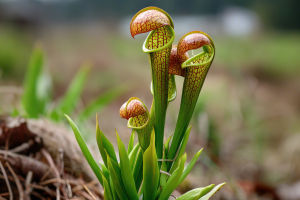Underground Plant Network

Hello, plant enthusiasts! Did you know that beneath the soil lies a vast, intricate network connecting plants through their roots and fungal partners?
This underground "social network" allows plants to share nutrients, communicate warnings, and support each other's growth. Today, we'll explore the fascinating symbiotic relationship between plant roots and fungi, known as mycorrhizal networks, and how they form nature's own "Wood Wide Web." Ready to dig in?
What Is the Mycorrhizal Network?
Mycorrhizal networks are formed when fungi connect their thread-like structures, called hyphae, with the roots of plants. This symbiosis benefits both parties: fungi receive carbohydrates produced by plants through photosynthesis, while plants gain enhanced access to water and soil nutrients like nitrogen and phosphorus beyond their root hairs' reach. These fungal networks extend far underground, linking multiple plants—even different species—into a shared system that facilitates resource exchange and communication.
How Plants and Fungi Communicate
Through the mycorrhizal network, plants can send chemical signals to each other. For example, when one plant is attacked by pests, it can transmit warning signals through the fungal network, prompting neighboring plants to activate their own defenses. Similarly, nutrients can be redistributed from nutrient-rich plants to those in poorer soil conditions, helping maintain community health and resilience. This underground communication resembles an "internet" for plants, enabling cooperation that was once thought impossible for these stationary organisms.
The Ecological Importance of Mycorrhizal Networks
Over 80% of terrestrial plants form mycorrhizal associations, making these networks vital for ecosystem functioning. They improve plant growth, increase resistance to drought and diseases, and enhance soil structure. By connecting diverse plant species, mycorrhizal networks promote biodiversity and stabilize plant communities. Forests, grasslands, and agricultural systems all benefit from these underground alliances, which help plants adapt to changing environments and stresses.
Recent Discoveries: Non-Host Plants and Network Complexity
Recent research reveals that even plants not traditionally known to form mycorrhizal associations can be influenced by these fungal networks. Some fungi can colonize non-host plant roots without forming typical structures, affecting their growth and immunity. This suggests the underground network is more complex and inclusive than previously believed, with potential implications for agriculture and ecosystem management. Scientists continue to investigate how these interactions shape plant communities and nutrient cycling.

How We Can Support These Underground Networks
Protecting soil health is key to maintaining mycorrhizal networks. Avoiding excessive tillage, reducing chemical fertilizers and pesticides, and planting diverse crops or native plants encourage robust fungal communities. Gardeners and farmers can foster these beneficial relationships by using organic mulches and composts and minimizing soil disturbance. Supporting these networks helps plants thrive naturally, reducing the need for artificial inputs and enhancing sustainability.
Let's Celebrate Nature's Underground Network!
The next time you walk through a forest or garden, remember the invisible web beneath your feet connecting plants in a remarkable partnership with fungi. Have you noticed healthier plants growing together or wondered how they survive tough conditions? Share your thoughts and experiences with us! Together, let's appreciate and protect this incredible "Wood Wide Web" that sustains life on Earth.
With curiosity and care, we can deepen our understanding of these underground connections and promote healthier ecosystems. Happy exploring!


